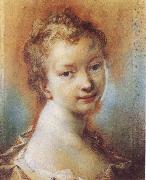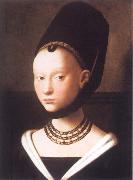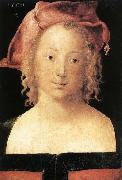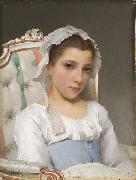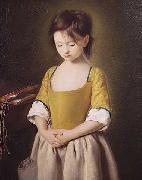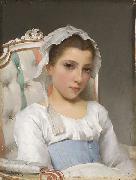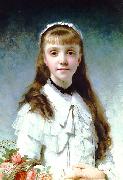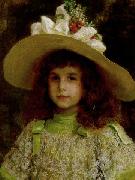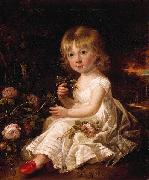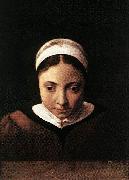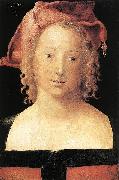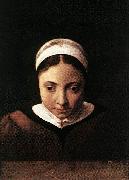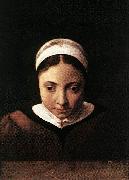Wholesale Oil Painting No Minimum |
|||||||||||
|
|
|||||||||||

|
|||||||||||
|
|
|
||||||||
Rosalba carrieraItalian Rococo Era Painter, 1675-1757 Italian pastellist and painter. She was a daughter of Andrea Carriera, who worked in the mainland podesteria of the Republic of Venice, and of Alba Foresti, an embroiderer. She had two sisters: Angela, who married the painter Giovanni Antonio Pellegrini, and Giovanna, who, like Rosalba herself, never married. Pier Caterino Zeno (see Campori, 1886) and other, anonymous sources recorded that she was a pupil of Giuseppe Diamantini; according to Mariette, she originally painted snuff-boxes and later became a pupil of Federico Bencovich. There are more precise records of her life and of some of her works from 1700 onwards |
||||||||
|
|
||||||||
Portrait of a Young Girl
Portrait of a Young Girl Painting ID:: 33789 |
mk86
after 1708
Pastel
36.3x30.3cm
Paris,Musee National du Louvre
mk86 after 1708 Pastel 36.3x30.3cm Paris,Musee National du Louvre |
|||||||
|
|
||||||||
Petrus ChristusFlemish 1415-1473 Petrus Christus Locations South Netherlandish painter. His known artistic career began in Bruges on 6 July 1444 when, as the Poorterboek (citizens register) for that day reveals, he purchased his citizenship ... in order to be a painter. Town records show that he and his wife became members of the Confraternity of the Dry Tree c. 1462; that in 1463 he and another painter, Pieter Nachtegale, were paid for the construction of a Tree of Jesse (destr.) and for the cost of assistants employed on the day of the religious procession in which it was used; and that on 19 March 1472 he served as a representative of the painters guild in a dispute with another painter, Jehan de Hervy the elder ( fl 1472-1507). These and a few other scattered references comprise the existing documentation for Christusa life and work. |
||||||||
|
|
||||||||
|
|
Portrait of a Young Girl
Portrait of a Young Girl Painting ID:: 40194 |
mk156
after 1446
Oil on panel
29x22.5cm
mk156 after 1446 Oil on panel 29x22.5cm |
||||||
|
|
||||||||
Albrecht Durerb.May 21, 1471, Imperial Free City of Nernberg [Germany] d.April 6, 1528, Nernberg Albrecht Durer (May 21, 1471 ?C April 6, 1528) was a German painter, printmaker and theorist from Nuremberg. His still-famous works include the Apocalypse woodcuts, Knight, Death, and the Devil (1513), Saint Jerome in his Study (1514) and Melencolia I (1514), which has been the subject of extensive analysis and interpretation. His watercolours mark him as one of the first European landscape artists, while his ambitious woodcuts revolutionized the potential of that medium. D??rer introduction of classical motifs into Northern art, through his knowledge of Italian artists and German humanists, have secured his reputation as one of the most important figures of the Northern Renaissance. This is reinforced by his theoretical treatise which involve principles of mathematics, perspective and ideal proportions. His prints established his reputation across Europe when he was still in his twenties, and he has been conventionally regarded as the greatest artist of the Renaissance in Northern Europe ever since. |
||||||||
|
|
||||||||
|
|
Portrait of a Young Girl
Portrait of a Young Girl Painting ID:: 63749 |
1507 Oil on panel tranferred from parchment, 30 x 20 cm Staatliche Museen, Berlin This small painting was in the collection of the Imhoff family of Nuremberg, and cited in their inventory from 1573-74 until 1628. In 1633, it was handed over, with the title Portrait of a Young Girl, with other works by D?rer, to Abraham Bloemart, an artist and merchant from Amsterdam. In 1899, the portrait reappears in London, and the firm P. and D. Colnaghi donated it to the Berlin art gallery. The delicate girl is portrayed with soft, curly blond hair, slightly dreamy her eyes, one somewhat lower than the other, a gentle, melancholic gaze; and well-defined, slightly parted lips. The red beret, worn sideways, with a little slit to the side, with a long red ruby and black pearl pendant, gives her a slightly cheeky air. The square green border of the red bodice sets off the upper part of her body. All these details put together have led to various interpretations. In addition to the fact that the "girl," when sold by the Imhoffs, was transformed into a "boy," Panofsky (1955) attributes an androgynous nature to her that could reveal the possible homosexual tendencies of the artist. A teasing letter of 1507 from the canonical Lorenz Behaim of Bamberg and the fact that the portrait does not seem to have been ordered would support this hypothesis. It has also been debated whether the painting was executed in Venice or after D?rer's return to Nuremberg. Considering the clothing to be typically German, there is no doubt as to its provenance.Artist:D?RER, Albrecht Title: Portrait of a Young Girl Painted in 1501-1550 , German - - painting : portrait 1507 Oil on panel tranferred from parchment, 30 x 20 cm Staatliche Museen, Berlin This small painting was in the collection of the Imhoff family of Nuremberg, and cited in their inventory from 1573-74 until 1628. In 1633, it was handed over, with the title Portrait of a Young Girl, with other works by D?rer, to Abraham Bloemart, an artist and merchant from Amsterdam. In 1899, the portrait reappears in London, and the firm P. and D. Colnaghi donated it to the Berlin art gallery. The delicate girl is portrayed with soft, curly blond hair, slightly dreamy her eyes, one somewhat lower than the other, a gentle, melancholic gaze; and well-defined, slightly parted lips. The red beret, worn sideways, with a little slit to the side, with a long red ruby and black pearl pendant, gives her a slightly cheeky air. The square green border of the red bodice sets off the upper part of her body. All these details put together have led to various interpretations. In addition to the fact that the "girl," when sold by the Imhoffs, was transformed into a "boy," Panofsky (1955) attributes an androgynous nature to her that could reveal the possible homosexual tendencies of the artist. A teasing letter of 1507 from the canonical Lorenz Behaim of Bamberg and the fact that the portrait does not seem to have been ordered would support this hypothesis. It has also been debated whether the painting was executed in Venice or after D?rer's return to Nuremberg. Considering the clothing to be typically German, there is no doubt as to its provenance.Artist:D?RER, Albrecht Title: Portrait of a Young Girl Painted in 1501-1550 , German - - painting : portrait |
||||||
|
|
||||||||
|
|
||||||||
|
|
Portrait of a young girl
Portrait of a young girl Painting ID:: 79045 |
Oil on wood
35 x 26.7 cm (13.8 x 10.5 in)
cjr Oil on wood 35 x 26.7 cm (13.8 x 10.5 in) cjr |
||||||
|
|
||||||||
Pietro Antonio RotariItalian painter , (b. 1707, Verona, d. 1762, St. Petersburg) Italian painter. His artistic career began as a youthful distraction, but his talent quickly became apparent, and he entered the studio of Antonio Balestra in Verona, remaining there until he was 18. He spent the years 1725-7 in Venice and then moved c. 1728 to Rome, where he stayed for four years as a student of Francesco Trevisani. Between 1731 and 1734 he studied with Francesco Solimena in Naples before returning to Verona, where he set up his own studio and school. His most notable early independent works are multi-figured altarpieces (e.g. the Four Martyrs, 1745; Verona, church of the Ospedale di S Giacomo), which emulate 17th-century Roman and Neapolitan works. However, he also studied the smaller, more intimate paintings of Roman Baroque artists, and these influenced his later works. He fell victim to the wanderlust that appears to have been endemic to 18th-century Venetian painters, and c. 1751 he travelled to Vienna, where he was able to study works by Jean-Etienne Liotard, whose clean pictorial smoothness impressed him. He later moved to Dresden |
||||||||
|
|
||||||||
|
|
Portrait of a Young Girl
Portrait of a Young Girl Painting ID:: 80864 |
18th century
Medium Oil on canvas
Dimensions ? x cm
cyf 18th century Medium Oil on canvas Dimensions ? x cm cyf |
||||||
|
|
||||||||
Hugo Salmson1843-1894 |
||||||||
|
|
||||||||
|
|
Portrait of a young girl
Portrait of a young girl Painting ID:: 82007 |
Medium Oil on wood
Dimensions 35 x 26.7 cm (13.8 x 10.5 in)
cyf Medium Oil on wood Dimensions 35 x 26.7 cm (13.8 x 10.5 in) cyf |
||||||
|
|
||||||||
Charles Joshua Chaplin(8 June 1825 - 30 January 1891) was a French painter and engraver. He was born in Les Andelys, Eure, France to an English father and a French mother. Although he spent the whole of his life in France, he only became naturalized in 1886. He died in Paris, France. Chaplin conducted art classes specifically for women at his studio. The American artist Mary Cassatt and the English artist Louise Jopling were among Chaplin's students. |
||||||||
|
|
||||||||
|
|
Portrait of a young girl
Portrait of a young girl Painting ID:: 82027 |
1881(1881)
Medium Oil on canvas
Dimensions 25 3/4 x 18 inches (65.41 x 45.72 cm)
cyf 1881(1881) Medium Oil on canvas Dimensions 25 3/4 x 18 inches (65.41 x 45.72 cm) cyf |
||||||
|
|
||||||||
Jean - Andre RixensFrench, 1846 - 1924 |
||||||||
|
|
||||||||
|
|
Portrait of a young girl
Portrait of a young girl Painting ID:: 82511 |
1892(1892)
Medium Oil on panel
Dimensions 33 x 24,1 cm
cyf 1892(1892) Medium Oil on panel Dimensions 33 x 24,1 cm cyf |
||||||
|
|
||||||||
Sir William Beechey1753-1839 British English painter. He was trained as a lawyer before entering the Royal Academy Schools, London, in 1772. He is thought to have studied under Johan Zoffany, and his earliest surviving portraits are small-scale full-lengths and conversation pieces in Zoffanys manner (e.g. The Custance Conversation Piece, c. 1786; priv. col.). Beechey first exhibited at the Royal Academy in 1776. In 1782 he moved to Norwich, where he gained several commissions, but he was back in London by 1787. In 1789 he exhibited a portrait of John Douglas, Bishop of Carlisle (London, Lambeth Pal.) that is remarkable for its facility of handling. Beechey would occasionally paint similarly inspired works, but his career is marked by a succession of unflamboyant but competent portraits in the tradition of Joshua Reynolds. |
||||||||
|
|
||||||||
|
|
Portrait of a Young Girl
Portrait of a Young Girl Painting ID:: 83623 |
19th century
Medium Oil on canvas
Dimensions 23 1/4 x 20 in. (59 x 51 cm).
cyf 19th century Medium Oil on canvas Dimensions 23 1/4 x 20 in. (59 x 51 cm). cyf |
||||||
|
|
||||||||
Cornelis van Poelenburch(1594 - 12 August 1667) was a Dutch Golden Age landscape painter. Though his birthplace is unknown, a signed document survives in Utrecht where he is listed as six years old and the son of Simon van Poelenburch, a Catholic canon in Utrecht.He initially trained with Abraham Bloemaert, and his earliest signed paintings are from 1620.He traveled to Rome where he was influenced by Adam Elsheimer and became a founding member of the Bentvueghels. He counted a few cardinals under his patrons, and was called to England by Charles I of England, for whom he made small cabinet pieces. He returned to Utrecht where he later died just a few years after his old teacher Abraham Bloemaert.He painted mostly small landcapes with mythical or religious figures or passages, in a style that would later be evident in some of the works of Claude Lorraine. His "most important and successful" pupils were Daniël Vertangen, Dirck van der Lisse, François Verwilt, and Jan van Haensbergen. Arnold Houbraken claimed that his best pupil was Joan vander Lis from Breda (not Dirk vander Lis from The Hague). Houbraken then mentioned Vertangen, Verwilt, Warnard van Rysen from Bommel, and Willem van Steenree, a nephew. The RKD also mentions Laurens Barata. |
||||||||
|
|
||||||||
|
|
Portrait of a Young Girl
Portrait of a Young Girl Painting ID:: 84606 |
Date first half of 17th century
Medium Oil on wood
Dimensions Height: 21 cm (8.3 in). Width: 17 cm (6.7 in).
cjr Date first half of 17th century Medium Oil on wood Dimensions Height: 21 cm (8.3 in). Width: 17 cm (6.7 in). cjr |
||||||
|
|
||||||||
Albrecht Durerb.May 21, 1471, Imperial Free City of Nernberg [Germany] d.April 6, 1528, Nernberg Albrecht Durer (May 21, 1471 ?C April 6, 1528) was a German painter, printmaker and theorist from Nuremberg. His still-famous works include the Apocalypse woodcuts, Knight, Death, and the Devil (1513), Saint Jerome in his Study (1514) and Melencolia I (1514), which has been the subject of extensive analysis and interpretation. His watercolours mark him as one of the first European landscape artists, while his ambitious woodcuts revolutionized the potential of that medium. D??rer introduction of classical motifs into Northern art, through his knowledge of Italian artists and German humanists, have secured his reputation as one of the most important figures of the Northern Renaissance. This is reinforced by his theoretical treatise which involve principles of mathematics, perspective and ideal proportions. His prints established his reputation across Europe when he was still in his twenties, and he has been conventionally regarded as the greatest artist of the Renaissance in Northern Europe ever since. |
||||||||
|
|
||||||||
|
|
Portrait of a Young Girl
Portrait of a Young Girl Painting ID:: 85311 |
Date 1507(1507)
Medium Oil on panel tranferred from parchment
Dimensions Height: 30 cm (11.8 in). Width: 20 cm (7.9 in).
cjr Date 1507(1507) Medium Oil on panel tranferred from parchment Dimensions Height: 30 cm (11.8 in). Width: 20 cm (7.9 in). cjr |
||||||
|
|
||||||||
Cornelis van Poelenburch(1594 - 12 August 1667) was a Dutch Golden Age landscape painter. Though his birthplace is unknown, a signed document survives in Utrecht where he is listed as six years old and the son of Simon van Poelenburch, a Catholic canon in Utrecht.He initially trained with Abraham Bloemaert, and his earliest signed paintings are from 1620.He traveled to Rome where he was influenced by Adam Elsheimer and became a founding member of the Bentvueghels. He counted a few cardinals under his patrons, and was called to England by Charles I of England, for whom he made small cabinet pieces. He returned to Utrecht where he later died just a few years after his old teacher Abraham Bloemaert.He painted mostly small landcapes with mythical or religious figures or passages, in a style that would later be evident in some of the works of Claude Lorraine. His "most important and successful" pupils were Daniël Vertangen, Dirck van der Lisse, François Verwilt, and Jan van Haensbergen. Arnold Houbraken claimed that his best pupil was Joan vander Lis from Breda (not Dirk vander Lis from The Hague). Houbraken then mentioned Vertangen, Verwilt, Warnard van Rysen from Bommel, and Willem van Steenree, a nephew. The RKD also mentions Laurens Barata. |
||||||||
|
|
||||||||
|
|
Portrait of a Young Girl
Portrait of a Young Girl Painting ID:: 88456 |
first half of 17th century
Medium Oil on wood
cyf first half of 17th century Medium Oil on wood cyf |
||||||
|
|
||||||||
Cornelis van Poelenburch(1594 - 12 August 1667) was a Dutch Golden Age landscape painter. Though his birthplace is unknown, a signed document survives in Utrecht where he is listed as six years old and the son of Simon van Poelenburch, a Catholic canon in Utrecht.He initially trained with Abraham Bloemaert, and his earliest signed paintings are from 1620.He traveled to Rome where he was influenced by Adam Elsheimer and became a founding member of the Bentvueghels. He counted a few cardinals under his patrons, and was called to England by Charles I of England, for whom he made small cabinet pieces. He returned to Utrecht where he later died just a few years after his old teacher Abraham Bloemaert.He painted mostly small landcapes with mythical or religious figures or passages, in a style that would later be evident in some of the works of Claude Lorraine. His "most important and successful" pupils were Daniël Vertangen, Dirck van der Lisse, François Verwilt, and Jan van Haensbergen. Arnold Houbraken claimed that his best pupil was Joan vander Lis from Breda (not Dirk vander Lis from The Hague). Houbraken then mentioned Vertangen, Verwilt, Warnard van Rysen from Bommel, and Willem van Steenree, a nephew. The RKD also mentions Laurens Barata. |
||||||||
|
|
||||||||
|
|
Portrait of a Young Girl
Portrait of a Young Girl Painting ID:: 90406 |
first half of 17th century
Medium oil on panel
Dimensions Height: 21 cm (8.3 in). Width: 17 cm (6.7 in).
cyf first half of 17th century Medium oil on panel Dimensions Height: 21 cm (8.3 in). Width: 17 cm (6.7 in). cyf |
||||||
|
|
||||||||
|
Cornelis van Poelenburch (1594 - 12 August 1667) was a Dutch Golden Age landscape painter. Though his birthplace is unknown, a signed document survives in Utrecht where he is listed as six years old and the son of Simon van Poelenburch, a Catholic canon in Utrecht.He initially trained with Abraham Bloemaert, and his earliest signed paintings are from 1620.He traveled to Rome where he was influenced by Adam Elsheimer and became a founding member of the Bentvueghels. He counted a few cardinals under his patrons, and was called to England by Charles I of England, for whom he made small cabinet pieces. He returned to Utrecht where he later died just a few years after his old teacher Abraham Bloemaert.He painted mostly small landcapes with mythical or religious figures or passages, in a style that would later be evident in some of the works of Claude Lorraine. His "most important and successful" pupils were Daniël Vertangen, Dirck van der Lisse, François Verwilt, and Jan van Haensbergen. Arnold Houbraken claimed that his best pupil was Joan vander Lis from Breda (not Dirk vander Lis from The Hague). Houbraken then mentioned Vertangen, Verwilt, Warnard van Rysen from Bommel, and Willem van Steenree, a nephew. The RKD also mentions Laurens Barata. Portrait of a Young Girl first half of 17th century Medium oil on panel Dimensions Height: 21 cm (8.3 in). Width: 17 cm (6.7 in). cyf |
||||||||
|
|
||||||||
|
Prev Next
|
||||||||
|
|
||||||||
|
Related Paintings to Cornelis van Poelenburch :. |
||||||||
|
|
||||||||
|
CONTACT US |
